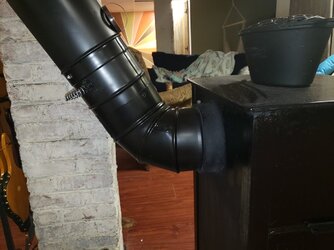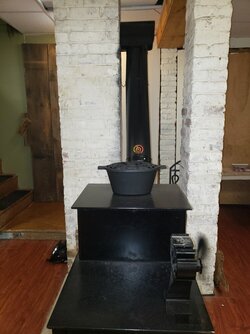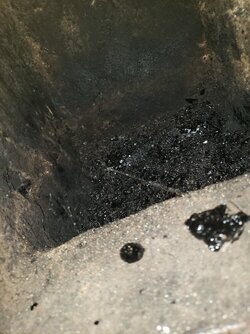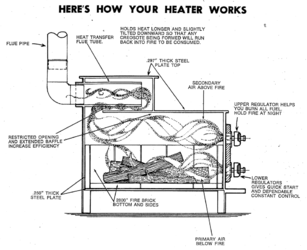Hello Folks!!
I have a 1970's Huntsman 241 wood burning stove attached to a 7x7 clay flue lined brick chimney that is 37ft tall.
The stove sits about 3 feet from the base of the chimney in my basement.
From the back of the stove I have a 6" 90 shaped to a 45 into a Dura black damper then 6' straight pipe to a 90 into the chimney near ceiling height.
Day burn stove temps are between 400-600 degrees, heat stat in Pic's above damper 12" above top of stove reads 400-500 normally, overnight dampened to burn 7-10 hours pipe temp is between 200-300 degrees. Unless my loving wife lets it go down during the day when I'm not home we tend to burn hot to heat 3 floors in a 3k SF house.
we tend to burn hot to heat 3 floors in a 3k SF house.
I have a moisture meter and the wood (Oak- Walnut) ranges from 10-20% on split two year seasoned and sheltered since Sept in a wood shed.
Attached pic's: Cleanout shows the chimney creosote knocked down from a quick clean just now while the stove pipe was being cleared and I have very very little debris as you can see. This chimney was cleaned professionally 3 months ago along with the pipe. I also cleaned the 6" between stove/chimney twice once I started burning in Nov. I have burned approx 1/2-3/4 cord so far.
The reason I had to clean it, is due to the throat damper shown in Pic's getting clogged not allowing it to close completely and or blocking exit gasses causing pipe and front regulators to smoke. I use Anti-Creo-Soot often as directed.
When having to clean the damper section I see the center holes completely block the first time and almost block this time and a ring of debris clogging the space between the plate and pipe so when you try to close the damper it completely seals the pipe like an HVAC damper backing smoke into the house.
Pic's show stat temp while bringing the stove back online after cleaning.
This is the first year it has done this to this extent, is this common? Hope I answered any questions in advance, I searched for a related issue prior!
Any help would be Much Appreciated!!
Thanks..



I have a 1970's Huntsman 241 wood burning stove attached to a 7x7 clay flue lined brick chimney that is 37ft tall.
The stove sits about 3 feet from the base of the chimney in my basement.
From the back of the stove I have a 6" 90 shaped to a 45 into a Dura black damper then 6' straight pipe to a 90 into the chimney near ceiling height.
Day burn stove temps are between 400-600 degrees, heat stat in Pic's above damper 12" above top of stove reads 400-500 normally, overnight dampened to burn 7-10 hours pipe temp is between 200-300 degrees. Unless my loving wife lets it go down during the day when I'm not home
 we tend to burn hot to heat 3 floors in a 3k SF house.
we tend to burn hot to heat 3 floors in a 3k SF house.I have a moisture meter and the wood (Oak- Walnut) ranges from 10-20% on split two year seasoned and sheltered since Sept in a wood shed.
Attached pic's: Cleanout shows the chimney creosote knocked down from a quick clean just now while the stove pipe was being cleared and I have very very little debris as you can see. This chimney was cleaned professionally 3 months ago along with the pipe. I also cleaned the 6" between stove/chimney twice once I started burning in Nov. I have burned approx 1/2-3/4 cord so far.
The reason I had to clean it, is due to the throat damper shown in Pic's getting clogged not allowing it to close completely and or blocking exit gasses causing pipe and front regulators to smoke. I use Anti-Creo-Soot often as directed.
When having to clean the damper section I see the center holes completely block the first time and almost block this time and a ring of debris clogging the space between the plate and pipe so when you try to close the damper it completely seals the pipe like an HVAC damper backing smoke into the house.
Pic's show stat temp while bringing the stove back online after cleaning.
This is the first year it has done this to this extent, is this common? Hope I answered any questions in advance, I searched for a related issue prior!
Any help would be Much Appreciated!!
Thanks..





 . But to me, that stove pipe looks like it hasn't really been fired very hot.
. But to me, that stove pipe looks like it hasn't really been fired very hot. 